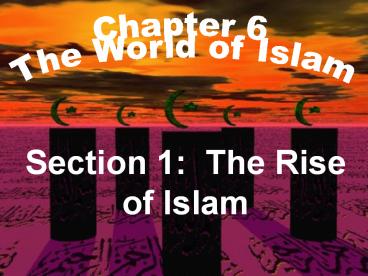Section 1: The Rise of Islam - PowerPoint PPT Presentation
1 / 29
Title:
Section 1: The Rise of Islam
Description:
Section 1: The Rise of Islam ... According to Islamic teachings, ... or engage in dishonest behavior. must base their family lives on marriage. – PowerPoint PPT presentation
Number of Views:343
Avg rating:3.0/5.0
Title: Section 1: The Rise of Islam
1
Section 1 The Rise of Islam
Chapter 6 The World of Islam
2
Say O Muslims We believe in God and that which
is revealed unto us and that which was revealed
unto Abraham, and Ishmael, and Isaac, and Jacob,
and the tribes, and that which Moses and Jesus
received, and that which the Prophets received
from their Lord. We make no distinction between
any of them and unto Him we have surrendered.
3
The BIG Idea
- Ideas, Beliefs and Values
- In the 600s, the Arabian prophet Muhammad
created the religion of Islam, which led to great
changes in the social and political system of
Southwest Asia.
4
The Arabs
5
- Western Asia has given birth to some of the most
powerful civilizations in history. - In the 7th Century, another forceThe Arabsarose
in the Arabian Peninsula and spread their
influence throughout Western Asia and beyond.
6
Arabian Peninsula
7
- Arabs organized themselves into tribes to help
one another survive the harsh environmental
conditions. - Each tribe was ruled by a Sheikh who was chosen
from one of the leading families by a council of
elders. - Each tribe was independent, yet loosely tied to
one another.
8
- Arabs lived as farmers and sheep herders on the
oases and rain-fed areas of the desert. - The camel was domesticated in the 1st Millennium
B.C. - Arabs populated more of the desert.
- Trade increased.
- Towns on the trade route began to develop.
9
Early Arab Religion
- Polytheistic
- Recognized a supreme god named Allah, but also
believed in other tribal gods - Arabs traced their ancestors to Abraham and his
son Ishmael - They were believed to have build a house of
worship called the Kabba at Makkah.
10
Kaaba
11
Black Stone
12
Disorder in Mesopotamia Egypt
- Led to.
- Dangerous trade routes in Southwest Asia
- Alternative trade travel through Makka and then
by ship across the Indian Ocean - Towns prospering along this route
- Increased tension between wealthy merchants and
poorer clans of people and slaves
13
The Life of Muhammad
14
Muhammad
- Born in Makka to a merchant family
- Orphaned by age 5
- Grew up to become a caravan manager
- Married a rich widow, Khadija
- Overtime Muhammad became concerned about the
growing gap between the generous Makkans and the
greedy ones - Deeply worried he began to visit the hills to
meditate
15
- During one of these visits, Muslims believe,
Muhammad received revelations from God. - According to Islamic teachings, the messages were
given by the angel Gabriel.
16
- Muhammad came to believe that Allah had already
revealed himself through Moses and Jesus (and
thus through the Hebrew and Christian
traditions). - However the final revelations of Allah were being
given to him.
17
- These revelations were written down and formed
the Quran, the holy book of Islam.
18
- The word Islam means peace through submission to
the will of Allah. - The Quran contains the ethical guidelines and
laws by which the followers of Allah are to live. - Those who practice the religion of Islam are
called Muslims. - Islam has only one God, Allah, and Muhammad is
Gods prophet.
19
- Muhammads wife, Khadija, urged him to follow
Gabriels message. She became the first convert
to Islam. - After 3 years, Muhammad had become discouraged in
his attempt to spread his message. - In 622, the year 1 of the Islamic calendar,
Muhammad and his supporters left Makkah and moved
north to Yathrib, later named Madihah.
20
- The journey to Madinah is known as the Hijrah.
- Muhammad began to win support from the people of
Madinah as well as Arabs in the desert known as
the bedouin.
21
- Submission to Allah also meant submission to his
prophet, so Muhammad soon became both a religious
and political leader.
22
- Muhammad put together a military force.
- In 630, Muhammad returned to Makka with 10,000
men. - After the city surrendered, and most of the
people converted to Islam, Muhammad declared the
Kabba a sacred shrine of Islam.
23
The Teachings of Muhammad
24
Islam is like Christianity and Judiasm
- Monotheistic
- Emphasis on salvation and offers the hope of an
afterlife - Those who desire to achieve life after death must
subject themselves to the will of Allah.
25
Islam is NOT like Christianity and Judiasm
- Islam does not believe that its first preacher
was divine. Muhammad was a man like other men.
26
Five Pillars of Islam
- Belief
- Prayer
- Charity
- Fasting
- Pilgrimage
27
(No Transcript)
28
Shari'ah
- Practical laws to regulate daily life
- Based on interpretations of Quran and example set
by Muhammad - Regulates all aspects of Muslim life
- Family
- Business
- Government
- Moral Conduct
29
Muslims...
- must worship according to the Five Pillars.
- must practice honesty and justice in dealing with
others. - are forbidden to gamble, eat pork, drink alcohol,
or engage in dishonest behavior. - must base their family lives on marriage.































